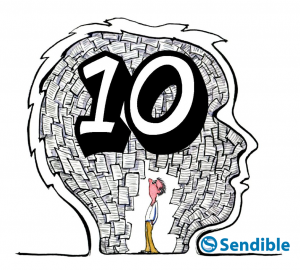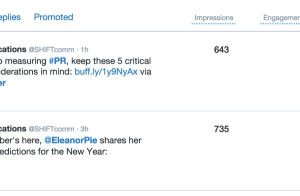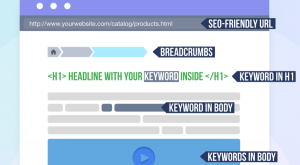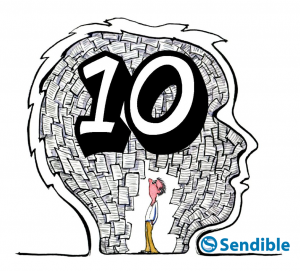 By Vishal Pindoriya, Published November 8, 2014
By Vishal Pindoriya, Published November 8, 2014
No one clicks on your links. No one comments on your posts or shares them. Why? There are a number of possible reasons, but the most likely is that your copy sucks. Fortunately, when it comes to raising the engagement level on your social media posts, the answers are as old as human psychology and advertising in general. The concepts are the same, even if the medium has changed and a few tweaks are necessary. Here are 10 tips that will get you more attention on social media.
 1. Define And Express Your USP
1. Define And Express Your USP
Every business should have a USP, or unique selling proposition, that differentiates it from the crowd. Otherwise you’re lost in the crowd with little hope of being noticed or garnering any significant share of the market. Why should potential customers buy from you instead of your competitors? Once you can answer this question, go through the exercise of turning the tables and asking the same question about your competitors objectively – why should they buy from them instead of you?
Once you’ve done this, you can then refine your answer until there is a distinct USP that you can identify for your company that you can’t apply to your competition. After you know what your distinct USP is, you need to be able to articulate it in a single sentence. When you can state your USP in a distinct, crisp, and easily understood sentence, make this message the center and foundation of your marketing. If your social posts can’t be tied to this message, you need to rethink them.
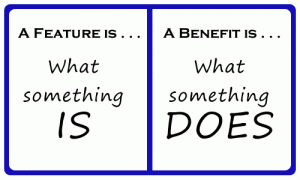 2. Focus On The Benefit Over The Feature
2. Focus On The Benefit Over The Feature
When you are posting to highlight some feature of your business or product, emphasize the benefit of the feature. You might post something like “Great News! Sendible now has scheduling!” There’s nothing wrong with this, except that it’s not going to get attention like this would: “Sendible just saved you a ton of time and effort. See how here.” While this is a simple example and not the best wording in the world, the point is clear.
Focusing on the benefit touches on needs, wants, or emotions that will resonate with readers more than listing the feature would. Not what it is, but how it will impact them. This doesn’t have to apply to some product or service feature either. Even if you’re posting a news story, a link to a blog post, or a funny video, the copy that you include in the post should draw them in emotionally somehow. Features are objective. Benefits are personal.
 3. Use PAS
3. Use PAS
The brilliant guys over at CopyBlogger call this the “copywriting formula to master any social media platform” – Problem, Agitate, Solution. Turn on the television for any length of time and pay attention to the commercials. How many of them start with something like “do you have problems with…?” It won’t necessarily be in that wording, but the idea is the same: bringing a common problem to the attention of those who experience it.
Using a fictitious sleeping aid, Snoozzz, as an illustration, the commercial might be summarized with: (P)Have trouble falling asleep? (A)Sleepless nights can ruin your days. (S)Snoozzz gives you a good night’s sleep. This formula can be adapted to almost any type of post as well, not just a product. Want them to watch your video about scary clowns? How about (P)Love clowns as a kid? (A)Have fond memories of them at the circus? (S)This video will totally change your perspective.
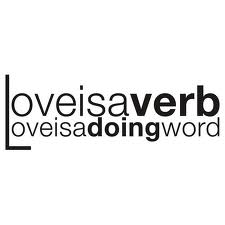 4. Use Strong Action Verbs
4. Use Strong Action Verbs
Your posts should be clear, concise, and to the point. One of the easiest ways to achieve this is by using active verbs instead of passive. This will help get rid of any fluff and whittle your post down to a sharp and clear point. “Man walking beside road is struck by bus” makes more of an impact when changed to “Bus strikes walking man”. Make your sentences short, concise, crisp, and full of strong action.
 5. Leave Them Hanging
5. Leave Them Hanging
You haven’t been on social media without seeing these types of headlines left and right:
They did this or that. You won’t believe what happened next.
This person was doing something when they found something shocking.
How being run over by a car was the best thing that ever happened to me.
These all introduce a titillating story or idea, but never tell you what actually happened. It gets interest piqued enough that people will click through to read the rest of the story. Humans want closure, and when they get a little pinch of something interesting they want to know the rest. This is a psychological ploy, but it’s tried and true and works more often than not.
 6. I’m talking To YOU
6. I’m talking To YOU
While it may not attract engagement from as wide an audience, this method will definitely engage a specific demographic. When people feel like you’re speaking directly to them they pay more attention, especially when there’s no question that they are your audience. Good copy usually comes across as a direct conversation rather than a broadcast.
For example: “If you have an autistic child, you need to read this now.” Every parent with an autistic child who sees that is highly likely to at least click through and see what it’s about. Not very post should have this level of specificity, of course, but if the opportunity presents itself it’s usually going to get engagement. This example also includes the next tip:
 7. Give A Sense Of Urgency
7. Give A Sense Of Urgency
This is another tool that can seem trite and overused sometimes, but it’s still effective because of our human nature. Almost all of us are victims to the fear of missing out. If you don’t act now, you’ll miss this forever and you’ll regret it. Even if we don’t believe it and understand that it’s a marketing ploy most of the time, that fear that we just might miss out on something big or important tends to get the best of us. Watch this shocking video before it gets pulled! or Stop what you’re doing right now and read this if you care about XYZ are a couple of good examples.
 8. Take a Different Angle
8. Take a Different Angle
Getting right to the point in your lede or headline doesn’t give anyone a reason to click through. They’ve got the idea, time to move on. A great example of this was shared recently on Newswhip’s blog post about how to write a good lead using a Mashable post about the Floyd Mayweather boxing match against Marcos Maidana, which was the second most-tweeted story in September. The headline wasn’t “Mayweather defeats Maidana” or anything else so mundane. Their lead: “Floyd Mayweather made almost $ 15K per second this weekend (again), how was yours?”
Whether you care a whit about boxing or not, that’s enough to draw some interest. Also note that the post was from Mashable, one of the top tech and social media sites on the web, and it is centered around a sport. You can draw interest from a wider audience if you can find a way to present a story in a unique way, especially if you can tie it back into your area of expertise somehow.
 9. Give A Clear Call To Action
9. Give A Clear Call To Action
Most of the best tips about writing an article or blog post also apply to social media posts, even if they’re on a smaller or more concise scale. That call to action won’t usually be the same type as your website, however. The goal is to get them to the website or blog, or to comment on the post. It’s on your blog or website that you want them to sign up for a newsletter, subscribe to your service, or buy your product.
In your social posts, you want to include calls to action such as Take this quiz to see… or Click to find out how you can…, as well as asking them to share or comment. You don’t have to include as many “salesy” calls to action on the post itself.
 10. Use An Interesting Quote Or Fact
10. Use An Interesting Quote Or Fact
I like to use one of the most provocative quotes or lines from an article as the lede occasionally on my posts. If you do this, make sure to keep the previous tips in mind. You don’t want to give the story away and keep them from clicking through. This is the same as articles where you see call-out quotes for tweeting or sharing. I just sometimes pick more interesting parts. You can also use a statistic or fact from the piece, which could be done with an attached image or graphic.
Now go forth and practice making your social posts more engaging. Of course, you’ll never know exactly how successful you are in your tweaks unless you have some good social media monitoring software that will track your engagement for you. After all, you do have other things to do too.
Social Articles | Business 2 Community
(264)
Report Post